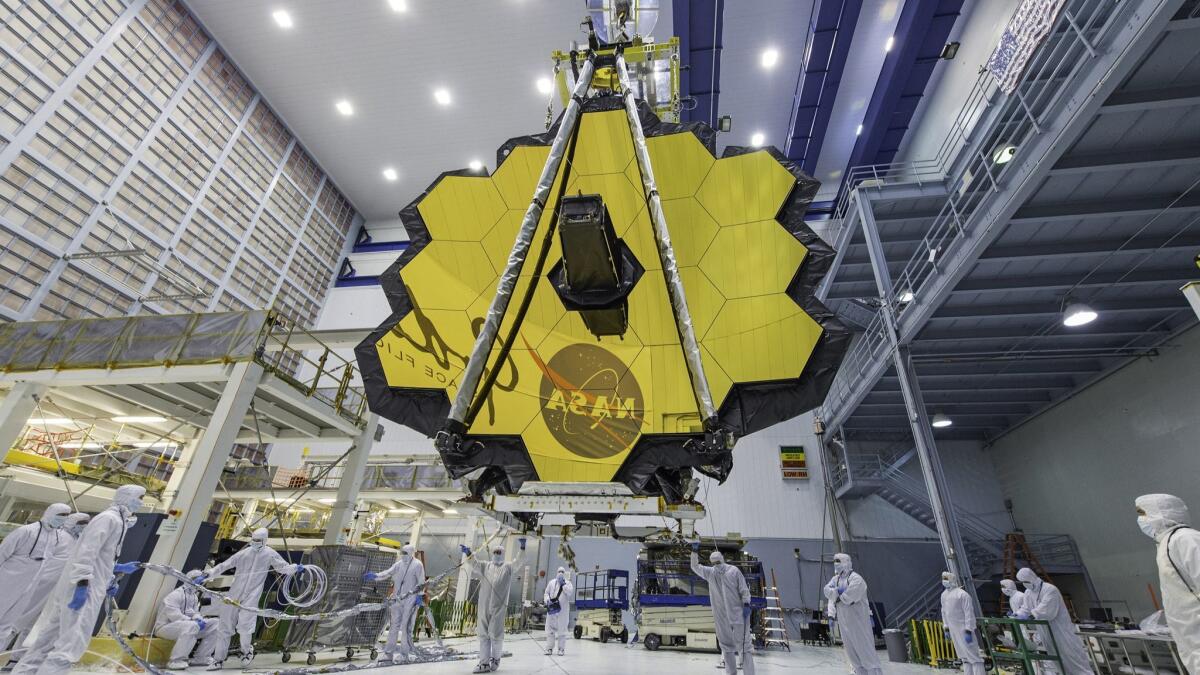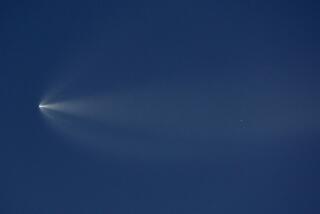Launch of James Webb Space Telescope, massive successor to Hubble, delayed to 2020

Billed as the successor to the Hubble Space Telescope, NASA’s long-awaited James Webb Space Telescope will now launch at least a year later than expected, and the program could be at risk of breaching an $8-billion development cost cap mandated by Congress, NASA officials said Tuesday.
The delays and potential cost overruns are the result of longer-than-expected testing and integration timelines, as well as mistakes made during the process, NASA said. Launch is now expected in May 2020, rather than June 2019.
NASA officials noted in a call with reporters Tuesday that there were several small tears in the telescope’s five-layered, tennis court-sized sun shield, which will protect the instruments and mirrors from the heat of the sun. Those tears have since been repaired.
Other issues included the replacement of valves in the spacecraft’s propulsion system after a cleaning solvent deteriorated the material around the valves.
“We want this to work well in orbit, so we cannot afford to make any shortcuts on the programs or any mistakes here,” said Thomas Zurbuchen, associate administrator of NASA’s science mission directorate.
The latest setback, disclosed Tuesday, follows a decade of delays and rising costs, starting from the early plans that the device would have a mirror six times larger than the Hubble and operate at 100 times the sensitivity, but somehow cost less to build.
Even with the best government management practices, the construction of the telescope was bound to be a challenge. The 21-foot-diameter mirror is focused by more than 100 motors on its back side. Made up of 18 hexagonal segments covered in a thin layer of gold, it is so big that it must be folded up for launch — another innovation.
The telescope, which will be launched on an Ariane 5 rocket, will help researchers better understand the origins of the universe. The Webb is composed of two main components — the optical telescope and science payload and the sun shield and spacecraft bus. The Webb’s total mass, including the payload adapter that connects it to the rocket, will be about 13,668 pounds.
Northrop Grumman Corp. is integrating the two halves and conducting testing at its Space Park facility in Redondo Beach. As of September, Northrop Grumman had 496 full-time workers on the telescope project — 387 more than planned because of technical challenges and work taking longer than expected, according to a U.S Government Accountability Office report released in February.
NASA officials said Tuesday that the agency would increase its interactions with Northrop Grumman to get more regular reports on progress. NASA has also convened an external, independent review board to monitor the telescope program.
Northrop Grumman said in a statement Tuesday that the company “remains steadfast in its commitment to NASA and ensuring successful integration, launch and deployment of the James Webb Space Telescope.”
The one-year launch delay will require keeping up to 1,000 total program employees on the payroll much longer than expected, a cost that could reach as high as $200 million, officials familiar with the space industry said. If costs increase that much, NASA could bust its $8-billion cost ceiling and be forced to go back to Congress for a new budget authorization.
“When they have these delays, everybody still gets paid and the marching army still comes to the office every day,” said John Pike, executive director of GlobalSecurity.org.
NASA had planned to shift some staff from operating the aging Hubble to the Webb when it becomes operational, said Cristina Chaplain, a space analyst at the GAO, who has written numerous reports on the Webb.
Congress nearly killed the program the last time NASA asked for a funding increase, though this time, the entire spacecraft is nearly built and an outright termination would be unlikely.
The telescope’s final destination — an orbit about 1 million miles from Earth — also puts added pressure on the team. Unlike the Hubble, the Webb was never planned to be serviced by astronauts.
It took 13 years for a space shuttle mission to repair the Hubble’s out-of-focus optics. The mission was considered one of the shuttle’s most important and successful missions.
“Simply put, we have one shot to get this right before going into space,” Zurbuchen said.
Twitter: @smasunaga








